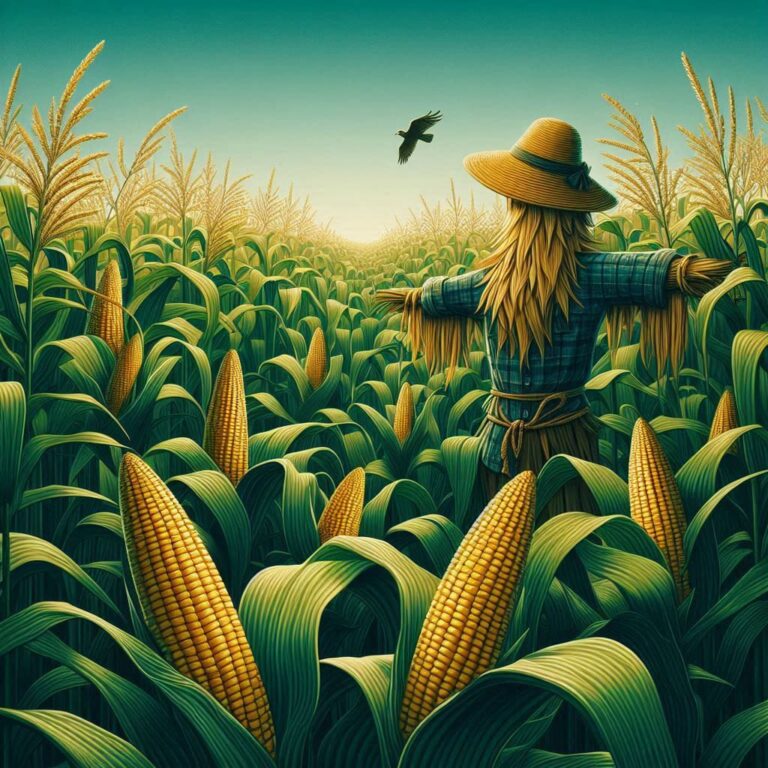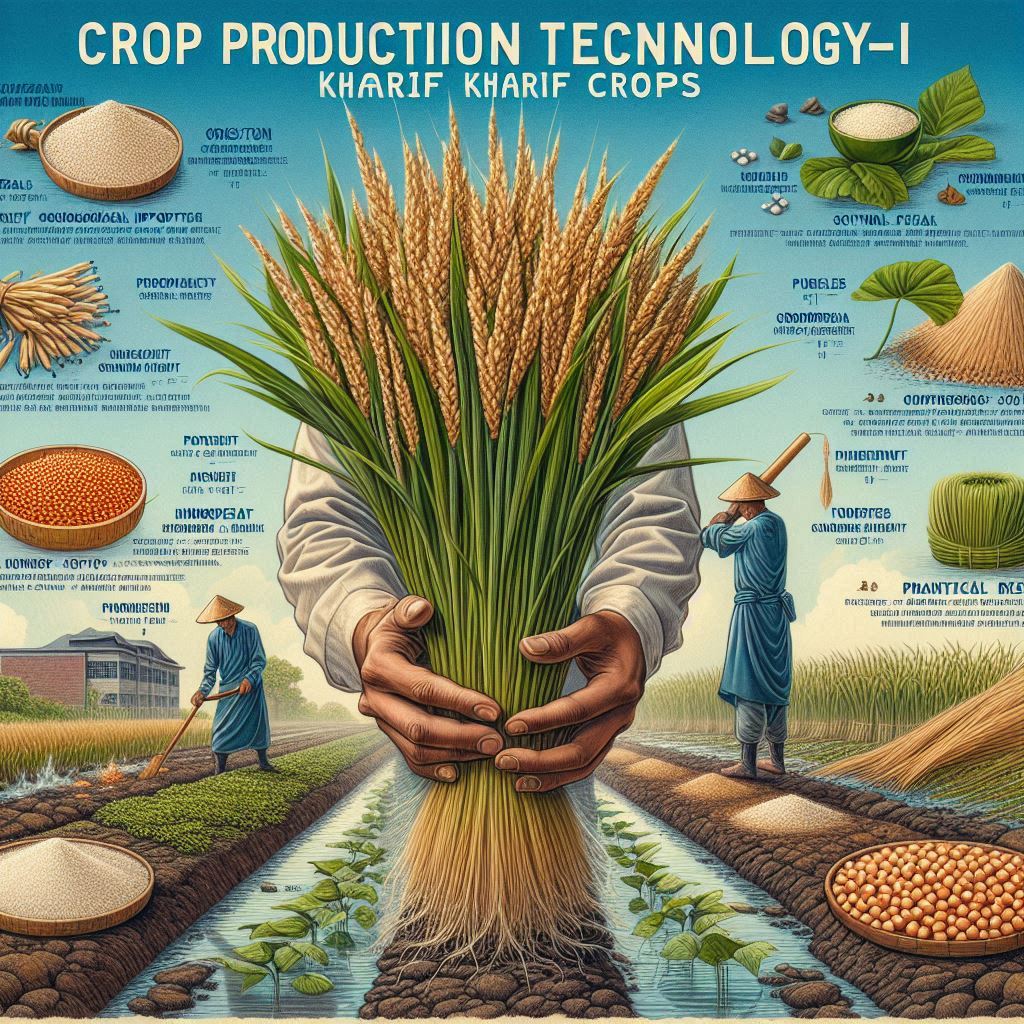AGRON – 211 Crop Production Technology – I (Kharif Crops)
CULTIVATION NOTES BSc Agriculture
- MAIZE – Zea mays
- Family – Poaceae
- 2n- 20
- Origin place –Central America and Mexico
Importance of Maize
- Maize is referred to as the “queen of cereals” due to its high yield per hectare among cereal crops.
- Grown in all countries except Antarctica.
- Adaptable to a wide range of climates.
- National Commission on Agriculture suggests increasing maize’s contribution to total food grain production from 6-7% to 10%.
- Mainly used as a food crop by the rural population.
- Commonly consumed in the form of bread and gruel.
- Maize has around 50 different industrial uses.
- Examples include the manufacture of starch, syrup, alcohol, acetic acid, lactic acid, glucose, paper, rayon, plastic, textiles, adhesives, dyes, synthetic rubber, resin, artificial leather, and boot polish.
Economic Importance
- Grilled Cobs: Cobs harvested slightly before maturation are grilled.
- Soups and Pancakes: Made from corn flour.
- Fermented Corn: Commonly consumed.
- Popcorn: A popular snack globally.
- Tortillas: Corn flour is processed into tortillas, especially in Mexico and Latin America.
- Corn Flour: Used to prepare corn flakes.
- Corn Germ Oil: A good cooking medium.
- Corn Starch: Raw material for many brews and jams, also used in producing alcohol.
- Starch-based Adhesive: Used in various industries.
- Corn Proteins: Utilized in pharmaceuticals and textiles.
- Corn Germ: Used in soap making.
Classification of Maize Types
- Dent Corn (Zea mays var. indentata Sturt)
- Description: Most common type grown in South America.
- Kernel Characteristics: Dent formation on the top, yellow or white color.
- Formation: The dent is due to rapid drying and shrinkage of soft starch.
2. Flint Corn (Zea mays var. indurata Sturt)
- Description: Widely grown in India.
- Kernel Characteristics: Soft and starchy endosperm in the center, hard outer layer, rounded top. Color may be white or yellow.
- Growing Regions: Europe, Asia, Central America, and South America.
3. Popcorn (Zea mays var. everta Sturt)
- Description: Known for its exceptional qualities.
- Kernel Characteristics: Small size, hard endosperm.
- Usage: Kernels explode when heated, used for human consumption, basis of popcorn confectionery.
- Cultivation: Mainly in the New World.
4. Flour Corn (Zea mays var. amylacea Sturt)
- Description: Possesses a soft endosperm.
- Kernel Characteristics: Soft kernels, commonly white and blue, fruit kernel shape.
- Growing Regions: USA and South Africa.
5. Sweet Corn (Zea mays var. saccharata Sturt)
- Description: Known for its sweetish taste.
- Kernel Characteristics: Sugar and starch are major components of the endosperm, resulting in a sweet taste before maturity. After maturity, kernels become wrinkled.
- Usage: Cobs are picked green for canning and table purposes.
- Growing Regions: Mainly in the northern half of the USA.
6. Pod Corn (Zea mays var. tunicata Kulesh)
- Description: Primitive type of corn with no significant importance.
- Kernel Characteristics: Each kernel is enclosed in a pod.
7. Waxy Corn (Zea mays var. ceratina Kulesh)
- Description: Known for its waxy appearance.
- Kernel Characteristics: The endosperm gives a waxy appearance when cut or broken.
- Usage: Produces starch similar to tapioca starch, used for making adhesives.
Soil Requirements for Maize
- Deep, fertile, rich in organic matter, and well-drained soils.
- Medium textured with good water holding capacity.
- Loamy or silty loam soil, or silty clay loam soil with fairly permeable subsoil.
- Very sensitive to water logging.
- Care required during rainy season to avoid water stagnation on the soil surface for more than 4-5 hours.
Ideal Soil Characteristics:
- Neither too clayey nor too sandy.
- pH range: 6.5 to 7.5.
- Exchangeable capacity: Around 20 milli-equivalent/100g.
- Base saturation: 70-90%.
- Bulk density: About 1.3 g/cc.
- Water-holding capacity: About 16 cm/m depth.
Climatic Requirements for Maize
- Planting to Emergence: 9 to 30°C.
- Emergence to Silking: Leaf number increases with temperature and photoperiod.
- Tasseling: Time to tassel increases as diurnal variation increases from 0-17°C.
- Maximum Growth Rate: Achieved at 30°C.
- Higher solar radiation enhances photosynthesis in maize.
Seasons for Maize Cultivation
Kharif Season:
- Sowing Time: With the onset of monsoon, i.e., in June or July.
- Harvesting Time: Late September or October.
Rabi Season:
- Sowing Time: From October to January, as an irrigated crop.
Optimal Sowing Time: Sowing maize about 5 days before the onset of the monsoon (last week of May to the second week of June) and providing irrigation can result in a good plant stand and highest grain yields.
Seed Bed Preparation for Maize
Tillage Operations:
- At least 2-3 shallow tillage operations during the summer season are essential in all maize growing areas.
Deep Ploughing:
- Helps control weeds.
- Aids in efficient moisture conservation.
Bed and Furrow or Ridge and Furrow Systems:
- Suitable for semi-arid and sub-humid regions.
High Rainfall Regions:
- Poor drainage can reduce yields.
- Dehradun Valley: ZINGG terracing system has been found suitable to address drainage issues.
Maize Kharif Varieties
Hybrid Maize
| Variety | Grain Type | Type of Corn | Duration (Days) | Yield (qt/hectare) | Stem Borer Infestation | Suitable Area |
|---|---|---|---|---|---|---|
| Ganga – 2 | White flat smooth | Long solid soft | 100-105 | 40-45 | Too much | UP plains |
| Ganga – II | Yellow | – | 100-110 | 45 | – | UP plains |
Composite Maize
| Variety | Grain Type | Type of Corn | Duration (Days) | Yield (qt/hectare) | Stem Borer Infestation | Suitable Area |
|---|---|---|---|---|---|---|
| Tarun | Yellow flat cylindrical | Long solid | 80-85 | 35-40 | Less | Whole (UP) |
| Naveen | Yellow round | Long solid | 80-85 | 35-40 | Less | Whole (UP) |
| Kanchan | Yellow orange | Round cylindrical | 75-80 | 35-40 | Less | Whole (UP) |
| Shweta | White | Round flat | 80-85 | 35-40 | Less | Whole (UP) |
| D-765 | Yellow round | Cylindrical | 75 | 30-35 | Less | UP plains |
| Surya | Yellow round | Cylindrical | 75 | 30-35 | Less | UP plains |
| Azad Uttam | Yellow orange | Round cylindrical | 70 | 35-40 | Less | UP plains |
| Novjyoti | Yellow orange | Medium size | 75 | 40 | – | Western UP |
| Mahi Kanchan | Yellow | Medium size | 80-85 | 40-45 | – | Whole UP |
| Local Merut | Yellow | Medium size | 75-80 | 20-25 | Less | UP plains |
| Jaunpuri | White | Medium size | 70-75 | 20-25 | Less | UP plains |
| Sartaj | Yellow | Long solid | 100-110 | 50-55 | Less | Whole UP |
| Prakash | Yellow | Long solid | 85-90 | 45-50 | Less | Whole UP |
| Deccan – 107 | Yellow | Long solid | 85-90 | 45-50 | Less | Whole UP |
| Prabhat | Yellow | Long | 100-110 | 40-45 | Less | Whole UP |
| Gaurav | Yellow | Long solid | 80-85 | 40-45 | Less | Western Central UP |
Rabi Maize Varieties
| Variety | Colour & Size of Grain | Duration for Corn Appearance (Days) | Duration (Days) | Production (qt/hac) |
|---|---|---|---|---|
| Hybrid Varieties | ||||
| Ganga-II | Orange – half flat | 85-90 | 150-160 | 70-80 |
| Deccan – 103 | Yellow – half flat | 85-90 | 150-160 | 60-80 |
| Deccan – 105 | Orange – half flat | 85-90 | 150-160 | 60-80 |
| Trisholta | Orange – half flat | 85-90 | 150-160 | 70-80 |
| High Starch | White – half flat | 85-90 | 150-160 | 70-80 |
Seeds and Sowing for Maize
- Optimum Plant Population:
- 60,000-80,000 plants/ha for good yields.
- Seed Rate:
- Pure Crop: 20-25 kg/ha (planting distances: 60×25 cm or 75×20 cm).
- Intercropping with Soybean:
- 15 kg/ha (1:2 ratio).
- 10 kg/ha (1:3 ratio).
- Fodder Maize: 40-50 kg/ha.
- Test Weight: Influences seed rate; high flexibility in crop geometry.
- Optimum Crop Geometry: 45×20 cm is recommended.
Method of Sowing:
- Dibbling:
- Seeds should be placed 2-3 cm deep (not more than 5 cm) alongside ridges, about 1/3 from the top.
- Ridge sowing aids in irrigation and drainage.
Weed Management:
- Importance: Timely weed control is crucial for aeration and yields.
- Common Weeds:
- Grasses: Cynodon dactylon, Echinochloa colonum.
- Sedges: Cyperus iria, Cyperus rotundus, Fimbristylis miliacea.
- Broadleaved Weeds: Celosia argentea, Commelina bengalensis, Convolvulus arvensis, Tribulus terrestris, Solanum nigrum, Phyllanthus spp.
Apply the pre-emergence herbicide, Atrazine 50 WP @ 500 g/ha (900 lit of water) at 3 days
after sowing as spray on the soil surface followed by one hand weeding on 40-45 days after
sowing.
- Apply herbicide when there is sufficient moisture in the soil.
- Do not disturb the soil after herbicide application.
- Hoe and hand weed on the 17th or 18th day of sowing, if herbicide is not applied.
NOTE: If pulse crop is to be raised as intercrop, do not use Atrazine.
Thinning and gap filling
- If two seeds were sown, leave only one healthy and vigorous seedling per hole and remove
the other on the 12-15 days after sowing. - Where seedlings have not germinated, dibble pre-soaked seeds at the rate of 2 seeds per hole
and immediately irrigate.
Hoeing, hand-weeding and earthing-up - Hoe and hand-weed on the 30th day of sowing.
- Earth up and form new ridges so that the plants come directly on the top of the ridges. This
will provide additional anchorage to the plants.
Water Management for Maize
- Maize is sensitive to both drought and waterlogging.
- Critical Periods:
- Flowering Stage: Most sensitive to moisture stress (tasselling and silking).
- Up to 40 DAS: Sensitive to excess moisture.
- Preflowering to Maturity: Sensitive to drought.
- Water Usage:
- About 50% of seasonal water intake occurs during the 5 weeks post-maximum leaf area (around tasselling).
- Continuous saturation of topsoil for even 4 days can reduce yield by 50 q/ha.
- Recommendations:
- Grow maize on ridges in areas with poor drainage or heavy rainfall, or on black soils.
- Popcorn is particularly sensitive to drought; moisture stress during early vegetative stages can delay flowering.
- Irrigation Method:
- The furrow method of irrigation is efficient and convenient for maize.
Manures and Fertilizers for Maize
- Nitrogen (N):
- Continuous supply needed throughout growth until grain formation.
- Deficiency symptoms: yellowing of lower leaf tips spreading to mid ribs and upper leaves; significant yield reduction can occur early.
- Phosphorus (P):
- Higher requirement in early stages; essential for plant tissues and developing grains.
- Deficiency noticeable before the knee-high stage; rapid decline in fertilizer contribution as maturity approaches.
- Potassium (K):
- Uptake occurs from knee-high to post-flowering stages; generally adequate in AP soils.
- Immediate correction required if deficiency is identified.
- Zinc (Zn):
- Zn deficiency is common in many maize-growing areas.
Recommended Fertilizer Doses (Kg/ha)
| Nutrient | Irrigated | Rainfed |
|---|---|---|
| Nitrogen (N) | 120-150 | 80-100 |
| Phosphorus (P) | 60-75 | 40-50 |
| Potassium (K) | Based on soil test | 35 |
| Zinc Sulfate (ZnSO4, once in 3 seasons) | 25-50 | 25-50 |
Fertilizer Application Guidelines
- Rainfed Crops: Apply all fertilizers in a single dose as basal dressing, 10 cm away and 5 cm below seed rows.
- Irrigated Crops:
- Apply 2nd and 3rd splits of N in the afternoon when there’s no dew.
- Mix fertilizers into the soil with a hand hoe and irrigate immediately after application.
- Top Dressing: For rainfed crops, ensure adequate soil moisture or apply after rain when soil is suitable.
- Zinc Deficiency: Apply 25-50 kg ZnSO4/ha as a basal dose, not mixed with phosphatic fertilizers.
Diseases and Pests of Maize crop
Downy Mildew: Peranosclerospora sorghi
Symptoms:
- Systemic infection as chlorosis which appears 10-14 days after infection.
- Leaves tend to be narrower and more erect.
- Plants infected early usually die at four weeks after infection.
- Chlorosis is noticeable on the lower half of the leaf (Half-leaf symptom).
- Chlorosis gradually covers the entire leaf surface at a later stage.
- A white downy growth is seen on the lower leaf surface under humid, warm conditions.
- Systemically infected plants do not form cobs, and if they do, the cobs are small and poorly filled.
Management:
- Use disease-free healthy seeds.
- Dry seeds to less than 14% moisture.
- Practice deep tillage and crop rotations for more than three years.
- Rogue diseased plants and alternate grass hosts.
- Use disease-resistant hybrids such as TNAU COH(M)6, COH(M)8, and COH(M)11.
- Treat seeds with metalaxyl @ 6g/kg of seeds.
- Apply foliar spray with metalaxyl + mancozeb @ 1000 g or mancozeb 1000 g/ha after initial symptoms or at 20 DAP and 40 DAP.
Leaf Blight: Exserohilum turcicum & Helminthosporium maydis
Symptoms:
- Long cigar-shaped grey-green to tan-coloured lesions on lower leaves.
- Tan lesions are slender and oblong, tapering at the ends, ranging in size from 1 to 6 inches.
- Lesions run parallel to leaf margins and coalesce to cover the entire leaf.
- Spores are produced on the underside of the leaf.
- Below the lesions, the fungus gives a dusty black/green fuzz appearance.
- Leaves become greyish-green and brittle, resembling leaves killed by frost.
Management:
- Burn or bury infected maize stubbles.
- Spray mancozeb or zineb @ 2-4 g/l or propiconazole 25% EC @ 1ml/l on 35 and 50 days after sowing (DAS).
Common Rust: Puccinia sorghi
Symptoms:
- Minute flecks appear on both sides of leaves.
- Circular to elongate cinnamon brown, powdery, erumpent pustules on both leaf surfaces.
- Brownish black pustules develop as the crop matures.
- In severe cases, infection spreads to the sheath and other parts.
Management:
- Remove alternate hosts.
- Destroy crop remains by burning or burying.
- Foliar spray of kresoxim-methyl 44.3% SC @ 1 ml/l or tebuconazole @ 1 ml/l or chlorothalonil or mancozeb @ 2 ml/l at 35 and 50 DAS.
Insects and Pests
Fall Armyworm: Spodoptera frugiperda
Symptoms of Damage:
- Scrapping of leaf surface by young larvae.
- Older larvae feed upon the central whorl, causing extensive defoliation.
- Whorl, tassel, and cob fed by larvae.
Management:
- Apply neem cake @ 250 kg/ha at the time of last ploughing.
- Treat seeds with cyantraniliprole 19.8% + thiamethoxam 19.8% FS @ 4 ml/kg seed.
- Border cropping with cowpea, gingelly, redgram, or sunflower (garden land) and fodder sorghum (dry land) @ 3 rows.
- Set up FAW pheromone traps @ 12 nos./ha.
- Spray azadirachtin 1500 ppm @ 2.5 lit/ha or chlorantraniliprole 18.5 SC @ 200 ml/ha or flubendiamide 480 SC @ 250 ml/ha at the early stage (15 – 20 DAE).
- Spray Metarhizium anisopliae (TNAU-MA-GDU isolate) @ 2.5 kg/ha or emamectin benzoate 5 SG @ 200 g/ha or novaluron 10 EC @ 750 ml/ha or spinetoram 11.7 SC @ 250 ml/ha at the late whorl stage (35 – 40 DAE).
- Use one of the insecticides recommended for late whorl stages at the cob formation stage if needed, but avoid repetition.
Stem Borer: Chilo partellus
Symptoms of Damage:
- Central shoot dries, leading to dead heart.
- Young larvae feed on tender folded leaves causing a “shot hole” symptom.
- Old larvae bore into the stem and feed on internal tissues.
- Boreholes and tunneling are noticeable on the stem.
Management:
- Inter-crop maize with cowpea in a 2:1 ratio.
- Release egg parasitoid, Trichogramma chilonis @ 250,000/ha thrice at weekly intervals.
- When infestation crosses 10%, spray dimethoate 30 EC @ 660 ml/ha or chlorantraniliprole 18.5 SC @ 150 ml/ha.
Shoot Fly: Atherigona orientalis
Symptoms of Damage:
- Infests crop from 2 days to 3 weeks after emergence.
- Maggots feed on young growing shoots causing dead heart.
Management:
- Treat seeds with imidacloprid 70 WS @ 10 g/kg or imidacloprid 600 FS @ 6 ml/kg or thiamethoxam 70 WS @ 3.5 ml/kg.
- Remove and destroy stubbles.
- Spray methyl demeton 25 EC @ 1000 ml/ha or dimethoate 30 EC @ 1155 ml/ha.
Corn Worm/Earworm: Helicoverpa armigera
Symptom of Damage:
- Larva feeds on silk, developing grains, and cobs.
Management:
- Set up light traps @ 1 no./ha.
- Set up Helicoverpa sex pheromone traps @ 12 nos./ha.
- Apply NPV twice at 10-day intervals at 1.5 x 10¹² POB along with crude sugar 2.5 kg + cotton seed kernel powder 250 g on the ear heads.
- Spray malathion 5D @ 25 kg/ha or phosalone 4D @ 5 kg/ha.
Harvesting
- Maturity of Hybrids:
- Takes 90-110 days.
- Maturity Test: Husk turns pale brown; grains are hard (not pressed by a fingernail).
- Cobs should be harvested at about 20% grain moisture.
- Plants may remain green even when cobs are ready, allowing for use as fodder.
Shelling
- Drying Time: Leave harvested plants in the field for 1-2 days to allow grains to dry.
- Husk Removal: Remove husks and place cobs in the sun for 2-3 days before shelling.
- Moisture Content: Grains should be less than 15% moisture for easy separation.
- Shelling Methods: Can be done by beating with sticks or using hand/power-operated shellers.
- Post-Shelling: Clean and dry grains thoroughly; store at 10-12% moisture.
Popcorn Harvesting
- Harvest at: 30-35% moisture, dried slowly in the shade to prevent cracking.
- Shelling Moisture: Ideal at 12% moisture.
- Storage Moisture: Maintain at 12% in waterproof bags for optimal popping (12-14% moisture).
Yield Attributes
- Number of cobs per plant.
- Number of grains per cob.
- Grain weight per cob.
- Test weight (100-grain weight).
Yield
- Hybrids: 35-40 Q/ha.
- Local Varieties: 15-20 Q/ha.
High Lysine Composites
Shakti:
- Duration: 95-100 days;
- Protein: 10.6%;
- Lysine: 3.45%;
- Yield: 45 Q/ha.
Rattan:
- Duration: 95-100 days;
- Protein: 10%;
- Lysine: 3.46%;
- Yield: 40-45 Q/ha;
- Tolerant to top borer and downy mildew.
Protina:
- Duration: 100-105 days;
- Protein: 11%;
- Lysine: 4%;
- Yield: 40-45 Q/ha.
READ MORE – RICE CULTIVATOIN




![[PDF] BSc Agriculture 3rd semester Notes Download](https://eagronomy.com/wp-content/uploads/2024/09/AddText_09-23-09.27.27.jpg)



Pingback: SORGHUM (Sorghum bicolor) Cultivation Notes BSc Agriculture